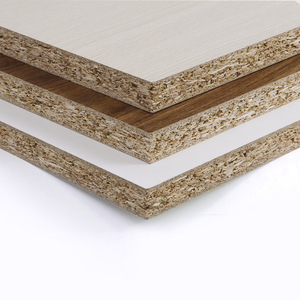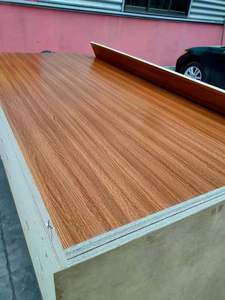(1442 products available)






















































































































































































































A thin particle board is a sheet material made from wood chips, particles, or sawdust mixed with adhesive and then compressed into a board. It is also known as chipboard or particleboard. This engineered wood product is widely used in furniture and interior design because of its affordability, versatility, and relatively lightweight nature compared compared to other wood-based panels. A thin particle board is available in various thicknesses, but the term “thin” generally refers to boards that are up to 1 inch thick. These boards are commonly used in applications where a lightweight and cost-effective material is required.
There are several types of thin particle boards based on usage. They include the following:
Standard Thin Particle Board:
They are also called interior-grade particle boards. They are designed for general-purpose use. They are commonly used in the construction of cabinets, desks, and drawers. Standard thin particle boards are frequently utilized as a substrate in the furniture industry, providing a cost-effective solution for tabletops, backs of sofas, and other furniture components that do not require high structural integrity.
Melamine-Coated Boards:
These boards feature a thin layer of melamine resin applied to one or both sides. The melamine coating provides a smooth, easy-to-clean surface. It also comes in various colors and patterns, including wood grain finishes. Melamine-coated boards are popular in the construction of laminate cabinets, office furniture, and countertops. They are also used to make affordable beds with storage.
High-Density Thin Particle Boards:
These boards have a higher density than standard boards. They are engineered to provide enhanced strength and stability. Their increased density is achieved through the use of finer particles and more adhesive during the manufacturing process. High-density boards are used in applications that require load-bearing capabilities. They are also used in making worktops, and in applications where a smooth surface finish is required, such as veneer press.
Moisture-Resistant Thin Particle Boards:
These boards are specially treated with chemicals during manufacturing to resist moisture. They are also called water-resistant boards. Their treatment helps to prevent swelling, warping, and degradation when exposed to humid environments. Moisture-resistant boards are commonly used in kitchens and bathrooms where high levels of moisture are prevalent. They are also used in the construction of built-in wardrobes.
Sound-Reducing Thin Particle Boards:
These boards are designed specifically to minimize sound transmission. They are manufactured with a combination of absorbent and dense materials. This helps to reduce noise levels. Sound-reducing boards are used in applications where acoustic control is required. For example, they are used in making office partitions, music studio walls, and other environments where noise reduction is essential.
Here are the key features of thin particle boards:
Cost-Effectiveness
Thin particle boards are popular among manufacturers because they are cost-effective. They are made from wood waste, which would otherwise be discarded. This means that even though they have different applications in construction and furniture making, they do not have a high price tag. This makes them accessible to manufacturers and homeowners who want to do DIY projects. The low cost does not mean that the boards are of low quality. They offer great value, which makes them a preferred choice for many projects.
Lightweight
Thin particle boards are lightweight. This makes them easy to handle and transport. This reduces the overall cost of a project since more money is not spent on transport. Their lightness also makes them a preferred choice for projects where weight is an important consideration, like in the construction of mobile homes and tiny houses.
Eco-Friendly
These boards are considered eco-friendly because they are made from wood chips, sawdust, and other wood waste. This helps to reduce environmental waste. It also makes the process of wood manufacturing more sustainable. Some manufacturers go a step further and add recycled wood waste to create a thin particle board. This promotes the recycling of materials.
Versatility
Thin particle boards are very versatile. They are used to build furniture, like wardrobes, bookshelves, and cabinets. They are also used as a subfloor material in construction. Because they come in different thicknesses and densities, manufacturers can choose the board that is most suitable for their project.
Stability
These boards provide a stable surface for construction projects that require it. They have a uniform surface that is stable, which means that they do not expand or contract when exposed to changes in temperature or humidity. This makes them a preferred choice for applications where dimensional stability is important.
Ease of Use
Thin particle boards are easy to work with. They can be cut, shaped, and nailed with particle board. This makes them a popular choice among manufacturers because they can easily be customized to fit the requirements of a specific project.
Thin particle boards are popular in the construction and furniture industries due to their affordability and versatility. They are used in a variety of applications including:
Choosing the right thin particle boards for sale involves considering several factors. Here are some of them:
Consider the Use
Assess the intended use of the thin particle board. Different applications require varying levels of strength, stability, and moisture resistance. For instance, if the board is meant for furniture construction, areas like drawers or sliding doors will require smoother surfaces and edges. Thus, boards with a smoother side, such as melamine boards, would suffice.
Check the Thickness
Carefully assess the load-bearing requirements when choosing the thickness of a thin particle board. Thicker boards provide additional strength and stability and are typically used in load-bearing applications like shelves and cabinet bottoms. However, thinner boards are more suitable for lightweight applications such as back panels and drawer bottoms.
Examine the Surface Finish
Pay attention to the surface finish of the thin particle boards. This is particularly important for visible applications. Boards with smooth surfaces are ideal for painting or veneering, while textured surfaces provide a unique aesthetic touch. Additionally, pre-finished boards with melamine surfaces reduce construction time and provide ready-to-use options.
Check the Edge Treatment
Edge treatment is an important aspect when aesthetics and durability matter. Consider the exposed edges during construction. Smooth edges provide a seamless transition and are ideal for veneering. On the other hand, textured edges add visual interest and are suitable for high-traffic areas.
Environmental Considerations
Opt for thin particle boards that are made with environmentally friendly practices. Many manufacturers indicate the formaldehyde emission levels in their boards. Boards with low formaldehyde emissions are better for indoor air quality. Additionally, consider the recyclability of the board at the end of its life cycle.
Q1: What are the common applications of thin particle boards?
A1: Thin particle boards are commonly used in the construction of drawer boxes, the back of cabinets, and other furniture. They are also used as a backing material for pictures and posters and in decorative wall coverings. Additionally, they are used as a substrate for laminated countertops, and in the automotive industry for interior panels.
Q2: How is a thin particle board different from MDF and plywood?
A2: While all these are engineered wood products, they have different compositions and characteristics. Thin particle boards are made of small wood particles mixed with adhesives, and they are less dense than MDF. Thin particle boards are more affordable than MDF and thinner than MDF and plywood.
Q3: Can a thin particle board be waterproofed?
A3: Yes, a thin particle board can be waterproofed by applying a waterproof sealant or coating. However, it is important to note that this will not make the board completely waterproof, and prolonged exposure to water should be avoided.
Q4: What are the standard sizes of a thin particle board?
A4: The standard thickness of a thin particle boards is 1/4 inches, and the standard size is 48 by 96 inches. However, they can be produced in different sizes and thicknesses depending on customer specifications or the intended use.
Q5: Can a thin particle board be recycled?
A5: Yes, a thin particle board can be recycled. However, the recycling process will depend on the type of adhesives used during manufacturing. Some adhesives are recyclable, while others are not.